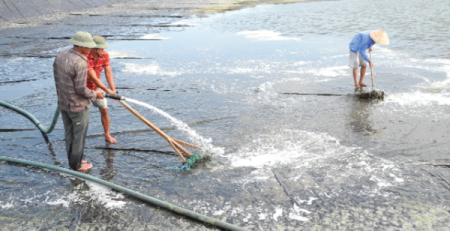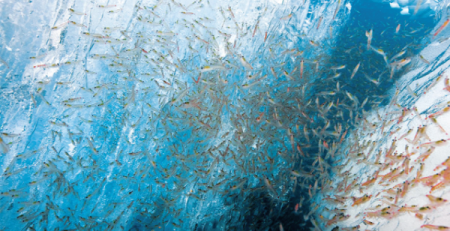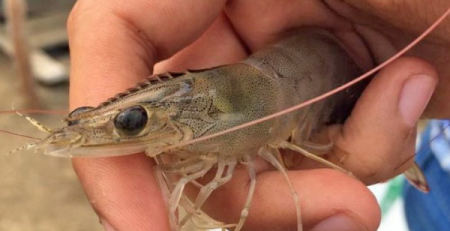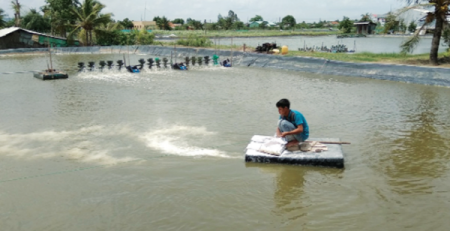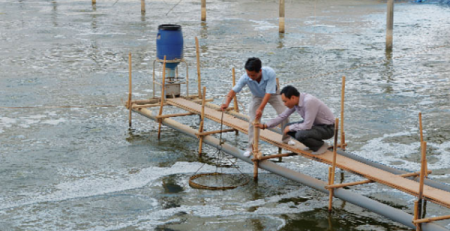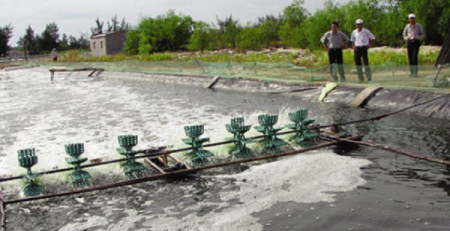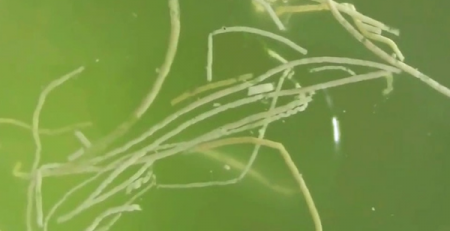Preventing diseases for shrimp at the time of the season
Every year, at the time of the seasonal outbreak of disease on shrimp, there is a risk of outbreaks. Therefore, in order to limit the negative impacts due to weather fluctuations, farmers need to have appropriate solutions to stabilize the environment and improve the resistance of shrimps.

Regularly check farmed shrimp for timely prevention measures Photo: Tran Ut
Nội dung bài viết [ẩn]
Pond
Ponds should be removed and cleaned, spread lime (concentrated in ditches). It is necessary to reinforce the pond bank firmly, keep the pond and keep the pond water level stable. In the process of mechanical renovation, mud sludge must not be allowed to flow out of rivers and canals.
Arrangement of sedimentation ponds with a depth of 2-3 m, ensure sufficient storage of cool water, process properly, ready to supply to ponds when necessary.
For extensive aquaculture ponds with large areas, it is necessary to reinforce the banks and solid culverts, in order to reduce water leakage. It is necessary to dig ditches in the lagoon, along the culverts, 0.5 – 0.8 m deep; 2 – 3 m wide and 5 m away from a ditch every 5 m; When it is hot, the shrimp will move down to avoid heat.
Ensure the environment
Every day, the environmental parameters should be measured, especially pH, oxygen, temperature, alkalinity … If outside the permitted threshold, it is necessary to find out the causes for timely handling. Farmers need to be equipped with environmental measuring instruments when any factors are beyond the scope suitable for shrimps, to take measures to promptly handle and adjust.
Always keep a reasonable level of culture water (not less than 1.2 m for industrial ponds and 0.5 m for shrimp-paddy fields, improved extensive), avoid light falling to the bottom and fluctuate Large day and night temperatures make shrimp “shocked”, an opportunity for harmful pathogens to attack.
Periodically every 7-10 days using agricultural lime (CaCO3), Dolomite – CaMg (CO3) 2, dose of 100-300 kg / ha to stabilize water quality and replenish minerals for shrimps. Note the addition of probiotics to the pond should be incubated with molasses and aeration within 3-6 hours before hitting the pond.
Minimizing the direct use of water sources outside rivers and canals and bringing them into the farming areas, it is necessary to actively supply clean water sources through settling ponds to supply and replace water for ponds when necessary. For ponds that are raising, limit the water supply, only relieve surface water when it rains heavily.
Feeding
At any stage of development, the requirement for feeding is not to allow for excess (causing waste and environmental pollution) or lack of food (causing slow growth of shrimp). Therefore, food management must be of special concern.
Shrimp feed must meet both quantity and quality. The amount of food in the day depends very much on the factors such as: development stage (large shrimp eat more when they are young), health status (shrimp is sick or molting less than usual), acting weather changes (cold or hot shrimp also reduce feeding), feeding time (nighttime eating more than daytime) and water quality (bad water environment tends to reduce feeding) … Therefore, farmers need monitor the situation in the pond to determine the appropriate amount of food.
The best way to feed in the hot season should be based on the actual needs of the shrimp and not on screening. Feeding should be avoided when it is too hot and need to adjust feeding time in the early morning, late afternoon or more at night. Also, need to rely on transparency. Clearness of less than 30 cm indicates that shrimp were over fed 2 – 4 days earlier.
Besides, it is necessary to choose good quality food. In addition to nutritional requirements (especially protein content), the food must ensure its characteristic color and taste; solubility, adhesion, size; low rate of dust … Absolutely do not use food with mold, rancidity, reduce quality of shrimp feeding.
In addition, punctual feeding and screening will help determine the exact feeding power of the shrimp so that food management will be more effective.Gửi phản hồi
Waste treatment
In the pond, if the amount of organic waste is too high, it will cause organic pollution. The long-term deposition of silt, shrimp manure, uneaten food and biological residues make the pond bottom polluted, producing toxic gases (H2S, NH3) that are harmful to shrimps. Therefore, it is necessary to periodically use probiotics, Zeolite or products containing Yucca active ingredients to support the decomposition of the substrate and release toxic gases, creating a clean environment for shrimp to live.
Limiting the use of antibiotics and pharmaceutical chemicals, because if used regularly, the drug can destroy beneficial microorganisms on the pond bottom, reduce the metabolism of organic matter suspended and deposited at the pond bottom.
Periodic siphoning removes waste in the pond. In the canvas system, design a hole in the middle of the pond to collect waste and PVC pipes running underground in the bottom of the pond to release the waste whenever opening the exhaust valve. For landfill ponds, use boats or buoys to sit on to move the siphon end of the entire pit. According to experience, the siphon every morning, the siphon time is only about 30 minutes to 1 hour per hole, this will limit a lot of waste deposited on the pond bottom, help maintain water quality and especially reducing the amount of microorganisms needed; or with the same amount of microorganisms, but the effect of microorganisms is better because the amount of waste in the pond is less. The loss of water each time the siphon is about 2% will be compensated from the treated pond.
Shrimp health management
In addition to observing the reaction, color, intestinal, hepatopancreas, and daily shrimp manure by checking feeding trays, farmers need to fish shrimp periodically every 5 – 7 days or after the pond has bad movements like substance. bad water or prolonged rain for shrimp health checks to take timely measures.
In the diet, regularly supplementing digestive enzymes, essential amino acids (Lysine, Methionine …), vitamins (C, D, A …), minerals (Ca, P …), Beta-Glucan … to help shrimp fast growth and good resistance to the negative impacts of the environment and pathogens.
When the shrimp in the pond have unusual signs, the first thing to do is to check carefully the environmental factors. If all are within good range, you can think about the problem. In this case, before proceeding to process, it is necessary to consult opinions of nearby area officials for the most appropriate solution and handling.
Regularly refer to technical guidelines on environmental management, shrimp health management in ponds.
According to Vietfish Magazine


